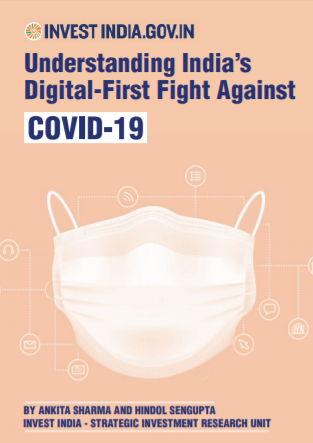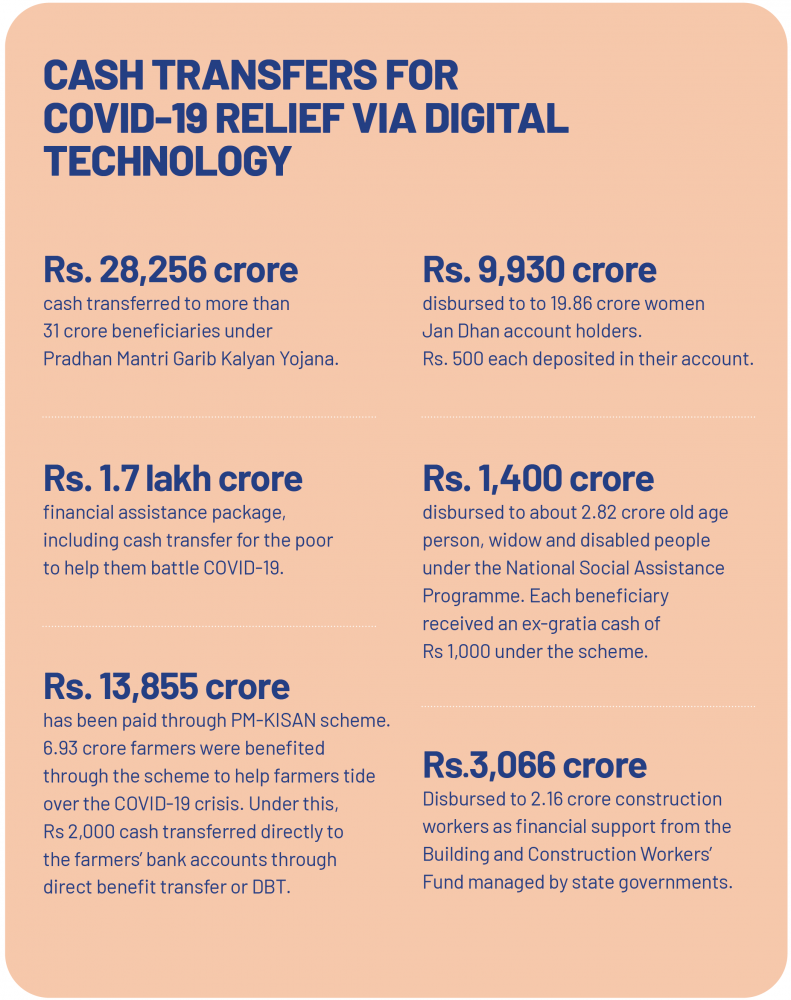Introduction

Prime Minister Narendra Modi has made digital technology a cornerstone of his public policy since 2014 with the creation of what is known as the JAM trinity (Jan Dhan bank account for the underprivileged, Aadhaar number and Mobile phone number). This allows easy transfer identification and transfer of government benefits including cash transfers.
India has more than 38 crore (380 million) Jan Dhan bank accounts[1] which have been used to transfer government benefits to around 590 million people in 2018-19 saving more than INR 51,000 crores (INR 1.41 trillion). Around INR 7.23 trillion has been transferred in government subsidies directly to bank accounts since 2014-15.[2]
More than 1 billion Aadhaar numbers have been issued covering more than 99% of all Indians. In 2019, the number of smartphone users in India crossed 500 million[3]. The JAM trinity is also the ‘enabler[4]' for the country’s Direct Benefit Transfer programme (DBT) which uses an electronic method to streamline delivery of cash transfers under government welfare schemes.
As the prime minister has written, “This seemingly simple connection has not only stopped corruption and rent-seeking that was going on for decades, but has also enabled the Government to transfer money at the click of a button. This click of a button has replaced multiple levels of hierarchies on the file and also weeks of delay.[5]”
Why the Jan Dhan-Aadhaar-Mobile (JAM) trinity is so powerful:
Introduced by the Narendra Modi government in the first term, the Jan Dhan scheme is proving to be a boon for millions of Indians seeking financial assistance during the ongoing countrywide COVID-19 lockdown. Its strong interlinkage with the mobile linked Aadhaar scheme has facilitated swift transfer of money into bank accounts of beneficiaries without pilferage or corruption.
In the words of Prime Minister Modi, “This infrastructure has helped us tremendously in transferring money directly and immediately to the poor and needy, benefiting crores of families, during the COVID-19 situation.”
With the lockdown placing immense strain on the household budgets of several sections of society, the JAM trinity is acting as a safety net and helping millions who need immediate monetary aid. Following are the key benefits that highlight JAM as an imperative in the current times:
- The JAM trinity has given a boost to the DBT program and expanded its coverage from partial to ubiquitous. Aadhaar has facilitated legitimate databases while Jan-Dhan has offered bank accounts for all.
- By eliminating the need for middlemen or conduits, JAM has helped minimize avenues of corruption, irregularities, wrong-doings and pilferages. It has also, therefore, promoted the ease of doing business.
- Given the need for physical distancing to curtail the spread of COVID-19, JAM is promoting online transactions among the beneficiaries, use of ATMs and payment cards instead of physical visits to the banks.
- In the longer run, DBT schemes like JAM will make the rural population get acquainted with the concept of ‘saving’, which would eventually like to a growth in the GDP of the country as a whole.
In a recent statement, the Finance Ministry said, “A digital pipeline has been laid through linking of Jan-Dhan accounts as well as other accounts with the account holders’ mobile numbers and Aadhaar [Jan Dhan-Aadhaar-Mobile (JAM)]. This infrastructure pipeline is providing the necessary backbone for DBT flows, adoption of social security/pension schemes, etc.[6]"
Digital Technology in Governance: Cornerstone of PM Modi’s Vision
Since 2014, the government has been actively promoting the use of digital technology and establishing nationwide online platforms to boost policy implementation, essential operations and transparency. Platforms like Aarogya Setu, Mygov.in and Namo have been widely appreciated, endorsed and used by millions of Indians today. As a result, critical COVID-19 related information dissemination, especially treatment protocols and healthcare services are being enabled largely online on digital multimedia.
Social media and online platforms have emerged during this crisis as key mediums that connect citizens with governments and allow all users to access the most credible information. These are truly powerful interfaces, amid the lockdown, that connect all people remotely and with minimal cost. More importantly, technology is not only fueling healthcare and emergency medical services but also alleviating the pressures placed on the supply chains and public distribution networks. “Embracing digital payments is a prime example of adaptability. Shop owners big and small should invest in digital tools that keep commerce connected, especially in times of crisis. India is already witnessing an encouraging surge in digital transactions,” according to Prime Minister Modi.
However, this is not an easy thing to accomplish given India’s massive population, gigantic size, economic disparities of citizens and huge scale of operations. Consider this: Indian government directly supports nearly 330 million beneficiaries through public welfare schemes.
To address this digital safeguard are playing a key role. For instance, the Aadhaar scheme, which provides all Indian citizens with a unique and verifiable digital identity, enables beneficiaries to avail services and benefits entitled to them without hassle. This includes the Jan Dhan accounts which take banking to the most impoverished and marginalized consumers eliminating the need for unnecessary paperwork-- thereby helping the government reduce costs and enhancing its efficiency.
Digitalization has also helped in the monitoring and evaluation of schemes whilst plugging loopholes. As PM Modi states, “After all, the most transformational impact of Technology often happens in the lives of the poor. It is technology that demolishes bureaucratic hierarchies, eliminates middlemen and accelerates welfare measures.”
The country is on the right path in its march towards leveraging technology and the following initiatives have been taken by the government both at the centre and state level in the wake of COVID-19:
| State / Government Body | Application |
| Central Government |
|
| National Informatics Centre (NIC), Government of India | 1921 - Conducting a telephone survey to garner feedback from citizens on prevalence and distribution of coronavirus symptoms and urged people to participate in the exercise in good measure. |
| Union Ministry of Electronics and Information |
|
| Chhattisgarh (collaboration with start-up Mobcoder) | Raksha Sarv |
| Gujarat | SMC COVID-19 Tracker |
| Himachal Pradesh | Corona Mukt Himachal |
| Maharashtra | Mahakavach: For contact tracing and quarantine tracking. |
| Karnataka | Corona Watch |
| Kerala | GoK Direct - Kerala: A simple corona news app |
| Goa (collaboration with Innovaccer) |
|
| Odisha | Odisha COVID Dashboard |
| Puducherry (collaboration with Innovaccer) | Test Yourself Puducherry |
| Punjab | COVA Punjab: Gives real-time coronavirus cases, measures, preventions, and latest updates |
| Tamil Nadu (collaboration with Pixxon Ai Solutions) | COVID-19 Quarantine Monitor |
| Uttarakhand | Uttarakhand COVID-19 Tracking System |

Global recognition for the efficacy of the JAM platform
The Center for Global Development[7] has noted that the JAM trinity enables the Indian government to make payments “more effectively and inclusively[8]”. The center has created a JAM Index based on Findex data (which tracks how adults save, borrow, make payments, and manage risk) to rank countries on their use of ID systems, mobile phones, and financial accounts to effectively make government payments. India and Kenya are two top ranking countries in this index. It notes that, “Cash-based social assistance can be delivered most efficiently and timely when the percentage of the population that has access to the three components — IDs, phones, and financial accounts — is high, systems are well-integrated, the existing system of benefits and transfers has wide coverage, and benefits are paid through financial accounts linked to the ID.[9]”
Conclusion
Not just the deployment but even the adoption of the digital technology as a counter to the novel coronavirus in India has been at record levels – the Aarogya Setu app, for instance, reached 50 million users in only 13 days.[10]
As Prime Minister Modi has written, “India has perhaps the largest such infrastructure in the world. This infrastructure has helped us tremendously in transferring money directly and immediately to the poor and needy, benefiting crores of families, during the COVID-19 situation.[11]”



